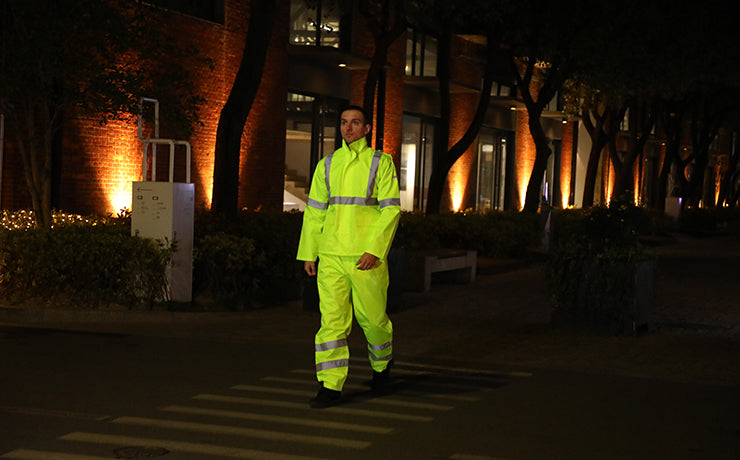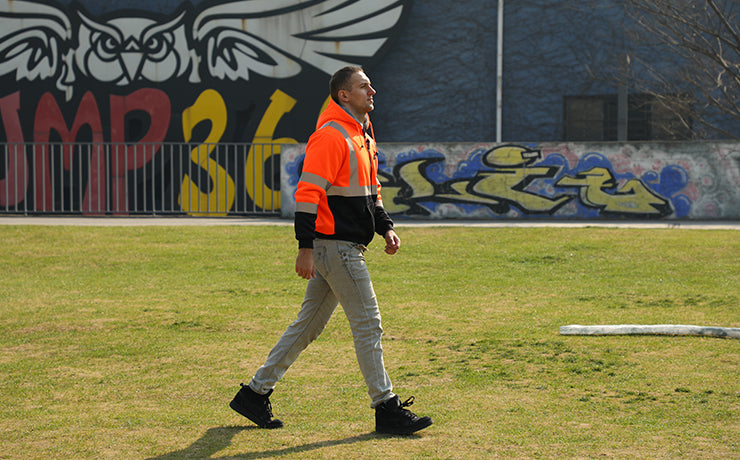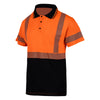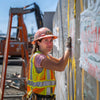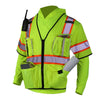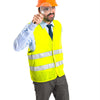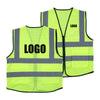OSHA Requirements for High Visibility Clothing - 2025 Guide
When working in hazardous environments, having high-visibility clothing can keep you safe from serious physical harm. For example, a bright-colored vest enables workers controlling huge vehicles to see you from a distance, hence they’re able to avoid hitting you. These vests, however, need to be of a certain standard to be considered ‘safe’ for such environments.
That is where OSHA comes in. For every safety apparel used in a high-traffic workplace, OSHA has implemented standards that need to be met in order to ensure occupational safety. So whether you work in a warehouse, a construction site, or any job site that involves being near vehicles, high-visibility garments can keep you safe. In this guide, we will take you through OSHA’s requirements for high-visibility garments in 2025.

What are High Visibility Garments and How do they Work?
High Visibility Safety Apparel(HVSA), also known as Hi Vis Clothing, or personal protective equipment, is a set of clothing made from fluorescent fabric and reflective material meant to increase your visibility in the workplace. These work clothes are designed to be visible even in low lighting conditions, thus keeping you and your team safe from accidents.
Hi-Vis clothing is classified into different categories based on the wearer's proximity to traffic, and the light levels in the work environment. Every class has a different requirement for the amount of reflective space allowed on the clothing.
Who is OSHA, and what are OSHA Safety Vest Requirements?
OSHA stands for Occupational Safety and Health Administration. It is a subsidiary of the Department of Labour tasked with establishing and enforcing standards, as well as offering assistance, outreach, education, and training in order to guarantee a safe and healthful environment for workers.
The general duty clause from the OSHA Act of 1970 requires that, in addition to compliance with hazard-specific standards, all employers provide a work environment "free from recognized hazards that are causing or are likely to cause death or serious physical harm."
Part 6 of the FHWA’s Manual on Uniform Traffic Control Devices (MUTCD) has several requirements that OSHA enforces with regard to flaggers and workers exposed to traffic. The manual on uniform traffic control devices states that all personnel who are in the right-of-way or may be exposed to vehicle or construction equipment traffic must have HVSA as part of their personal protective equipment.
According to the OSHA guide, flaggers must dress in an orange or yellow vest, shirt, or jacket while working during the day. For nighttime work, flaggers should wear a ‘retroreflective’ vest, jacket, or shirt that reflects back a significant portion of headlight beams. The nighttime clothes can be fluorescent, but they have to abide by OSHA’s color requirements. Nighttime safety vests also need to be visible from at least 1000 feet. Drivers should distinguish the wearer as human and be able to make out their body movements at a minimum.
What Colors are Acceptable for High Visibility Safety Apparel?
The occupational safety and health administration stipulates certain safety vest color codes based on their visibility from certain distances and how they contrast with backgrounds. The most common colors are; fluorescent yellow-green, and orange-red.
So what colors of safety vests are acceptable and at what times? In most job sites and work environments, fluorescent yellow-green is the most popular safety vest color. However, before picking a vest color, you need to take into consideration the surroundings and background as well.
For example, when working outdoors in park areas, the yellow-green vest will blend in with the green from trees and grass, thus making it unsafe for such job sites. In such cases, fluorescent orange-red vests are more appropriate.
For a more in-depth breakdown of the most appropriate colors for safety vests, you can visit: How to Choose the Right Colors for Your Working Environment.
What are the OSHA Standards for Retroreflective Material?

Apart from high visibility material, safety vests also need to have retroreflective material that increases visibility. Retroreflective material refers to the reflective straps attached to safety vests around the arms, over the shoulders, and around the waist. Their purpose is to reflect back any light that lands on them, thus increasing your visibility, especially to drivers.

To ensure safety, you can also use Custom Embroidered Patches on the clothing. The design uses high-visibility colors, which can not only be attached to our high-visibility clothing but also act as our retroreflective material.
In addition, in order to show the identity of the person wearing the High Visibility Safety Apparel, you can also use custom patches to show their name or code.
If you want to add some personal elements to your high-visibility clothing, you can customize high-visibility patches with personal elements. It is a very good idea to customize the patches on the badges, which can improve the appeal of clothing.
These straps come in a variety of shapes and sizes, and OSHA standards play a role in determining how thick or thin they ought to be. The retroreflective material(reflective strap) must be at least 1 inch in width, and it must be positioned on the safety vest to outline the human form. The most common placement is around the torso and limbs. The strap must also be visible from a minimum distance of 1,000 feet. That way, even drivers can make out the shape of your body as you work, and avoid hitting you.
When Does OSHA Require High Vis Clothing?
Anyone working on a street, adjacent to a road (including a highway right-of-way), next to or on a railroad track, or around large construction equipment is required by OSHA to wear high-visibility personal protection equipment, especially upper body reflective apparel. These comprise shirts, hoodies, vests, and jackets.
OSHA requires workers exposed to the dangers of being struck by hazards to wear hi vis safety vests when working. These workers include construction workers, warehouse workers, parking lot attendants, airport ground crews, emergency responders, and even law enforcement personnel such as traffic officers.
Note: OSHA also requires you to wear high visibility clothing when working at construction sites or highway work zones both during the day and night.
OSHA’s Safety Standards for Reflective Clothing
OSHA regulations require different workers to wear different standards of ANSI/ISEA 107-approved high-visibility safety apparel based on:
-
Their proximity to moving traffic
-
Imminent danger of being hit by moving vehicles
-
The complexity of the background and weather conditions
-
The surrounding lighting conditions
The manual on uniform traffic control devices MUTCD also assigns different occupations different safety apparel based on worker safety conditions. Below, we discuss some of the performance classes of safety apparel and which is right for your kind of work. Make sure to wear the correct class of reflective clothing to avoid penalties for you or your workers.
What are the Performance Classes of High Vis Safety Clothing?
High Visibility Safety Apparel can be classified into three different categories depending on the amount of background material, and the type of reflective strip. Classes 1, 2, and 3 have varying reflective surface areas, with performance class 1 being the lowest. This means you cannot wear class 1 safety clothing in highway work zones.
Performance Class 1 High Visibility Clothing Requirements

This class has the least reflective surfaces compared to other classes. Therefore, it is not suitable for working around high vehicular traffic areas. Since the reflective material is little, the wearer blends into the background instead of standing out from it, which can be detrimental if working on a site with huge vehicle operators.
Requirements for a performance class 1 safety garment according to ANSI/ISEA 107 include:
-
A background material of at least 217 square inches
-
When used with a bright background, the combined performance material/reflective tape should cover an area of about 155 square inches.
-
Without a bright background, the combined performance materials or reflective tape should cover an area of 310 square inches.
Class 1 garments are ideal in situations where the wearer can pay undivided attention to oncoming traffic, or places where there is a huge separation from moving traffic. Note that in cases where the traffic is in motion, vehicles should not be moving at speeds above 25 mph.
Examples of workers that can use class 1 HVSA include warehouse workers, parking lot attendants, and sidewalk workers.
Performance Class 2 High Visibility Clothing Requirements

If your work involves working near highways or around traffic, then you need to have performance class 2 or 3 HVSA. Performance class 2 safety apparel has more reflective area than class 1 safety garments, and therefore can be used in more complex job sites, provided there is a barrier between the workers and the traffic/road. Class 2 background area and reflective tape requirements include:
-
There must be background material covering a minimum of 755 square inches.
-
A minimum area of 201 square inches must be covered by the background and combined performance materials or reflective tape.
-
Even though anyone wearing this high visibility apparel can operate close to traffic throughout the day, there should still be a barrier between them and the moving cars.
Class 2 garments are ideal in environments with high visibility requirements such as during the day due to inclement weather conditions, ie snow, as well as areas with complex backgrounds. Workers permitted to use Class 2 HVSA include utility workers, roadway construction workers, and survey crews.
Performance Class 3 Safety Clothing Requirements

Performance class 3 safety apparel provides the highest level of visibility, with the largest reflective surface. This type of HVSA works well for work sites where workers are required to interact directly with traffic or pedestrians. It can also be used in environments with complex backgrounds.
ANSI/ISEA 107 requirements for class 3 HVSA are:
-
The safety clothing must make the wearer visible from a distance of at least 1280 feet
-
There must be at least 1,240 square inches of background material.
-
At least 310 square inches of reflective tape or combined performance material must be used with the background.
-
Either sleeves or class e pants must be worn with the hi vis apparel.
You can combine a performance class 2 or class 3 safety vest with class e safety pants to create a Performance class 3 ensemble.
What are the differences between OSHA and ANSI/ISEA 107?
ANSI/ISEA 107 stands for American National Standards Institute. They are a group of volunteers that research and recommend standards for various safety attire and are more specific as compared to OSHA.
OSHA is, in essence, a government entity or a component thereof. They create guidelines that become laws. Since ANSI standards The consequences of breaking the rules include penalties, fines, and even termination from your job.
Should Employers Pay for PPE like HiVis Clothing?

Under OSHA's manual, employers and employees both have a responsibility to make sure they are compliant with any HVSA requirements. Although OSHA mandates that your employees wear safety gear, you are not required to pay for it. If you demand that employees bring their own high-visibility clothing/protective gear, it is your responsibility to make sure that it complies with OSHA regulations and that it continues to function even after several uses.
Are there Penalties for Non-compliance?
Yes, there are penalties for noncompliance with OSHA standard for high visibility clothing. OSHA’s mission is “to ensure safe and healthful working conditions for workers by setting and enforcing standards, and by providing training, outreach, education, and assistance.”
The most important words here are “setting and enforcing standards” Since OSHA is governed by congress, they have the power to create regulatory laws. Employers and workers can suffer harsh penalties such as fines, and even termination from your job, for not complying with these laws.
Frequently Asked Questions
How Long Does High Visibility Clothing Last?
Just like other garments, high visibility clothing does not last forever. In fact, hi vis gear wears faster with daily usage than other clothes. To be safe, you need to inspect your high visibility clothing each time before wearing it. The reflective straps fade over time, and the background material can also get worn out easily. Make it common practice to replace your HVSA every 6 months depending on how often you use it.
Does OSHA Require High Visibility Apparel in Warehouses?
Yes. Warehouse workers are still in danger of collisions with other workers, and need to wear class 1 or 2 safety vests to be safe and remain compliant with OSHA standards.
Are Black Safety Vests OSHA Approved?
Black safety vests can become compliant with OSHA or ANSI ISEA 107 standards if they have a sufficient amount of reflective tape attached to them. While black safety vests are not recommended for construction workers, other workers such as warehouse supervisors or sidewalk workers not directly working on-site can wear them. However, make sure the combined performance material of the vest meets at least the required surface area requirement for class 1 HVSA.
What is Considered High Visibility Clothing?
High Visibility clothing refers to garments that increase your visibility in poor lighting conditions. The performance class of high visibility clothing varies based on your proximity to traffic, the type of work involved, and the amount of light on site.
What is the Difference Between Class 2 and Class 3 High Visibility Garments?
A class 2 reflective vest has less combined performance material compared to a class 3 safety vest. Class 3 reflective clothing usually has sleeves, and pants in order to meet the 1280 square-inch visibility requirements, while class 2 HVSA only has 755 square inches of background material, with at least 201 square inches of reflective tape.
Conclusion
There you have it, all you need to know to stay compliant with OSHA requirements for high-visibility clothing in 2025. Just remember, if you're not sure about what performance class to pick for your job, pick the next higher class. That way, you can be sure you're complying with OSHA regulations. If you're looking for a good selection of high-visibility safety apparel, don't hesitate to visit our store for amazing deals on your high-visibility clothing. If you need further assistance, contact us for more information.

